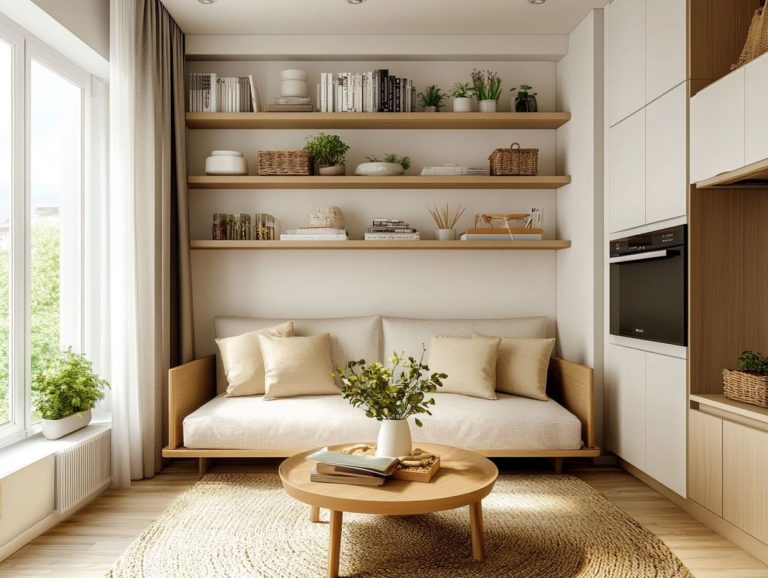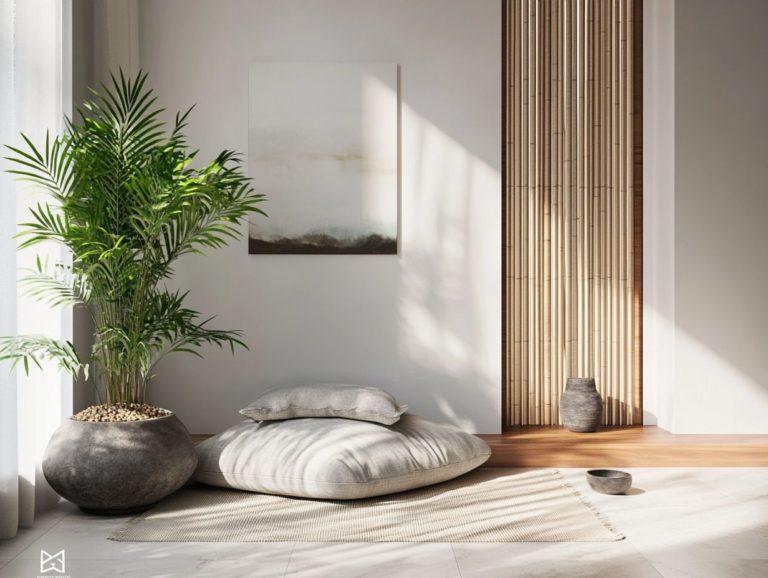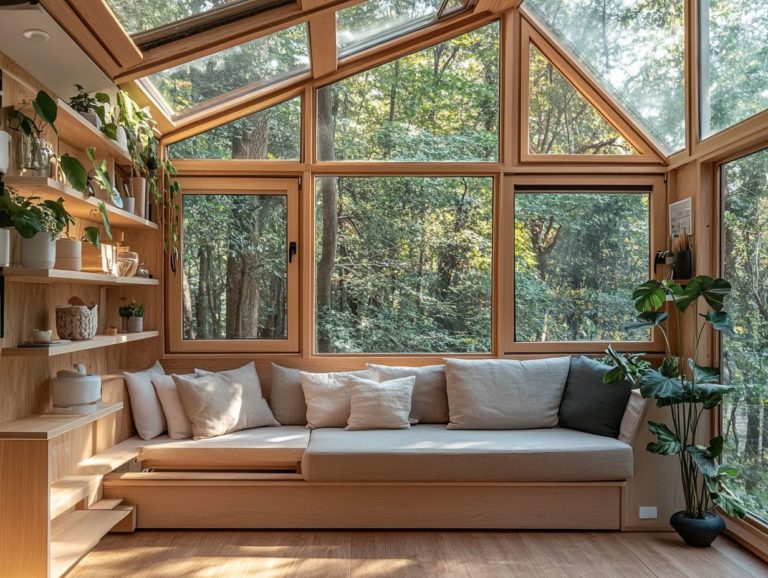Understanding Flow in Tiny Home Design
Tiny homes transcend mere minimalism; they represent a distinctive architectural philosophy where every inch is meticulously considered.
Among the pivotal concepts shaping these compact living spaces is “flow.” Grasping how flow influences both the design and functionality of a tiny home can transform a seemingly cramped area into an efficient and harmonious living environment.
This article delves into the dimensions of flow, the various factors that influence it, and innovative design solutions that elevate both space and functionality. This ensures your tiny home is as beautiful as it is practical.
Discover how to create a smooth living experience in your tiny sanctuary that you’ll love coming home to!
Contents [hide]
- Key Takeaways:
- The Concept of Flow in Tiny Home Design
- Factors Affecting Flow in Tiny Home Design
- Designing for Optimal Flow
- Common Flow Issues in Tiny Homes
- Innovative Solutions for Flow in Tiny Homes
- Frequently Asked Questions
- What is flow in tiny home design?
- Why is understanding flow important in tiny home design?
- How can I improve the flow in my tiny home design?
- What common mistakes should I avoid when designing the flow of my tiny home?
- Can I still have a functional and comfortable flow in a tiny home with a minimalist design?
- How can I incorporate my personal style into the flow of my tiny home design?
Key Takeaways:

- Flow is crucial in tiny home design as it contributes to the functionality and efficiency of the space.
- Space, layout, and natural light are important factors to consider in optimizing flow in tiny homes.
- Creative design and multi-functional furniture are innovative solutions to address flow issues in tiny homes.
The Concept of Flow in Tiny Home Design
The concept of flow in tiny home design is crucial for crafting a harmonious living space that prioritizes usability and comfort. To achieve optimal flow, you must understand the arrangement of rooms and incorporate space-saving strategies that resonate with the principles of minimalist living.
In tiny homes, where every square foot counts, your design choices should facilitate a seamless transition between spaces. This approach not only fosters an environment that feels larger and more inviting but also embraces the distinctive essence of the tiny house movement. Consider utilizing hallways in tiny house design to enhance your space optimization.
Factors Affecting Flow in Tiny Home Design
Numerous factors influence the flow in tiny home design, shaping not only how effectively the space is utilized but also how it is experienced by its occupants.
Space and Layout Considerations
Space and layout considerations are paramount in your tiny house design, as they significantly influence the overall flow and functionality of your home. When crafting these compact living areas, a strategic room arrangement becomes essential, ensuring that every square foot is utilized to its fullest potential.
A thoughtfully designed floor plan will guide you in placing space-efficient fixtures, such as multipurpose furniture and built-in storage solutions. This not only helps eliminate clutter but also enhances the aesthetic appeal of your environment.
Using smart design principles like open spaces and plenty of light can transform your home into a welcoming oasis. This approach fosters a sense of openness while promoting a harmonious living experience that beautifully balances comfort and practicality.
Functionality and Efficiency
Functionality and efficiency lie at the heart of tiny house design, ensuring that every feature has a purpose and contributes to your comfort.
This focus encourages the use of innovative, multifunctional furniture that meets diverse needs within those limited spaces. Imagine transformable sofas that effortlessly convert into beds or foldable dining tables that adapt to your gatherings. Each piece is thoughtfully crafted to maximize usability while maintaining an appealing aesthetic.
Clever storage solutions, like built-in cabinetry and under-bed compartments, help you stay organized without sacrificing that clean, uncluttered look.
As the demand for efficient tiny home innovations rises, you ll find a wave of designs prioritizing versatility, allowing you to fully embrace your minimalist lifestyle while making the most of every square foot of your living area.
Designing for Optimal Flow

Designing for optimal flow in tiny homes demands a meticulous balance between maximizing space and ensuring functionality, all while seamlessly integrating natural light and airflow.
Ready to transform your tiny home? Start designing today!
Maximizing Space and Functionality
Maximizing space and functionality in your tiny home often calls for creative design solutions. This includes using multifunctional furniture and innovative layouts.
By embracing strategies like hidden storage, you can make the most of every nook and cranny. Transform those underutilized areas into practical, organized spaces. Picture convertible furniture pieces, like sofa beds or extendable dining tables, allowing you to effortlessly transition between relaxation and social gatherings.
Incorporating vertical storage options, such as wall-mounted shelves or cabinets that stretch up to the ceiling, ensures your essential items are always at hand. This maintains an open and airy ambiance. These clever design choices can transform your small space into a stylish haven!
Incorporating Natural Light and Airflow
Incorporating natural light and airflow into your tiny house design is crucial for crafting a bright and healthy living environment.
Position windows wisely and choose open floor plans to maximize sunlight streaming into your interior spaces. This creates a more inviting atmosphere that elevates your mood and overall well-being.
You can also use airflow between rooms where windows on opposite walls align to allow fresh air to flow freely throughout your home. This approach not only satisfies your ventilation needs but also prevents stagnation, resulting in improved air quality. Such mindful design principles are essential for achieving both aesthetic appeal and functional comfort in compact living spaces.
Common Flow Issues in Tiny Homes
Common flow issues in tiny homes can greatly impact your livability and overall experience within the space. These challenges often stem from poor room arrangements or inefficient design strategies that hinder functionality and comfort.
Identifying and Addressing Flow Problems
Identifying and tackling flow problems in tiny houses is essential for creating a functional and enjoyable living space.
Understanding how the layout influences your daily activities can greatly enhance your overall livability. Be mindful of common flow issues, such as awkward transitions between rooms, insufficient storage solutions, and poorly planned traffic patterns.
To address these challenges, consider incorporating multifunctional furniture that maximizes your space. Strategically placed lighting can help create an inviting atmosphere.
Utilizing open shelving or vertical storage can minimize clutter and facilitate easier movement throughout your home. Thoughtful design choices like the placement of countertops or seating can contribute to smoother navigation, making your everyday tasks not only more efficient but also more enjoyable.
Innovative Solutions for Flow in Tiny Homes

Innovative solutions for enhancing flow in tiny homes frequently hinge on imaginative design concepts and the strategic use of multi-functional furniture. Embracing creativity in this space allows you to maximize every square inch while maintaining a sense of openness and functionality.
Creative Design Ideas
Creative design ideas are vital for achieving the perfect balance of functionality and flow in tiny homes. These innovative concepts can elevate limited spaces into efficient living areas that exude both spaciousness and warmth.
Consider multifunctional furniture, like foldable tables or Murphy beds beds that fold into the wall when not in use. These maximize your space and enhance usability by facilitating seamless transitions between various activities.
By incorporating vertical storage solutions think wall-mounted shelves or under-stair cabinets you can keep clutter in check while adding visual interest to your space. Additionally, strategically placed windows that invite natural light can significantly enhance the sense of openness and connectivity to the outdoors, transforming your tiny home into a truly expansive and welcoming environment.
Utilizing Multi-functional Furniture
Utilizing multi-functional furniture is a key strategy in your tiny house design. It allows you to maximize space while ensuring comfort and style.
This innovative approach to home furnishings sparks creativity and embodies the essence of minimalism. Minimalism means living with only what you need, enabling you to make the most of every square inch.
Pieces like sofa beds and extendable dining tables work wonders. They transform your space to suit your needs, whether you re enjoying a cozy evening or hosting a lively gathering.
Storage ottomans and modular shelving units blend practicality with aesthetics. This ensures that no corner goes to waste. Incorporate these versatile items and watch your tiny home transform!
Your tiny home can offer both functionality and warmth, creating a livable space that doesn t compromise on design flair.
Frequently Asked Questions
What is flow in tiny home design?
Flow in tiny home design refers to how well everything fits together in your space. It involves planning the layout and organization of a small living area to maximize efficiency and functionality.
Why is understanding flow important in tiny home design?

Understanding flow is crucial because it directly impacts the livability and functionality of the space. A well-designed flow can make a small living area feel larger and more comfortable.
How can I improve the flow in my tiny home design?
There are several ways to improve the flow in your tiny home design. Start by decluttering and minimizing items in your living space. Use multi-functional furniture and storage solutions to maximize space.
Carefully consider the placement and layout of furniture. Utilize natural light to enhance the overall flow of the area.
What common mistakes should I avoid when designing the flow of my tiny home?
Avoid overcrowding the space with too much furniture. Each area should have a clear purpose and function. Neglecting to utilize vertical space can also hinder flow.
Be mindful of creating dead-end spaces that disrupt the overall flow.
Can I still have a functional and comfortable flow in a tiny home with a minimalist design?
Yes, a minimalist design can enhance flow in a tiny home. By keeping the design simple and clutter-free, you create more space for movement, allowing for a comfortable and functional environment.
How can I incorporate my personal style into the flow of my tiny home design?
The key to incorporating personal style is to select furniture and decor that reflect your individuality while considering their functionality. Use color and texture to add character without compromising flow.






